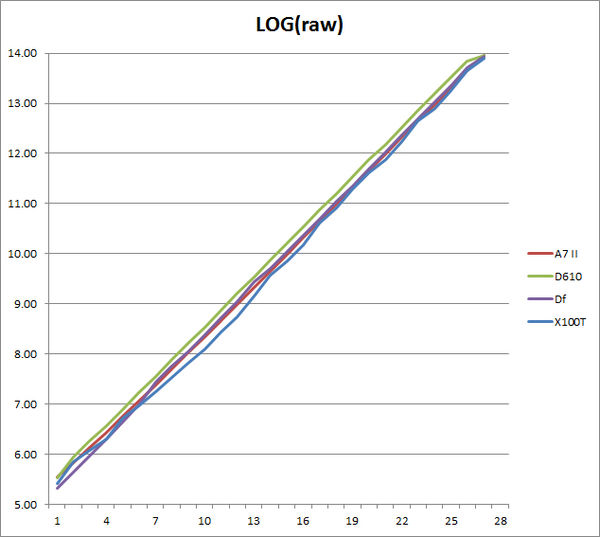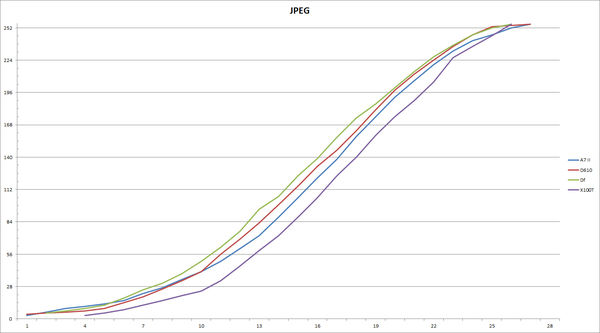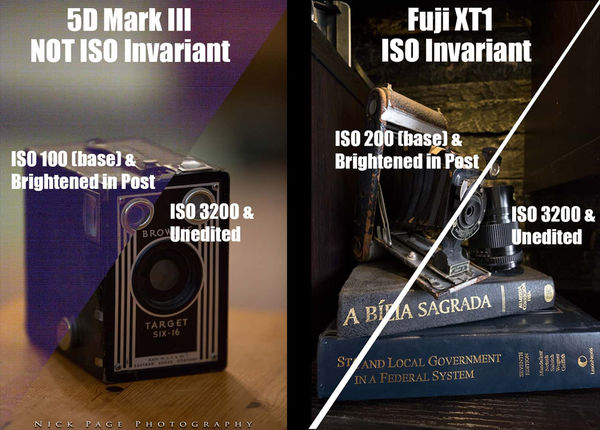Exposure compensation
Oct 11, 2019 19:10:58 #
selmslie wrote:
Raises it when? During the creation of the raw da... (show quote)
How many times do we have to remind you that the Canon world is bigger than both Nikon and Sony combined?
This example shows clearly, even to the disbelieving or just oddly argumentative, the differences between two example cameras.
Oct 11, 2019 19:29:32 #
CHG_CANON wrote:
How many times do we have to remind you that the Canon world is bigger than both Nikon and Sony combined?
This example shows clearly, even to the disbelieving or just oddly argumentative, the differences between two example cameras.
This example shows clearly, even to the disbelieving or just oddly argumentative, the differences between two example cameras.
So what? Tata sells more cars than Jaguar. What does volume have to do with quality?
In case you have forgotten the two plots I was referring to, here they are again. The only one that's a little flakey is the X100T because uses a less precise leaf shutter up to 1/4000s.
Do you think Canon is different?
Raw response to changes in illumination from middle gray -5 stops through middle gray +4 stops

(Download)
JPEG response straight from the camera over the same 9 stops

(Download)
Oct 11, 2019 19:40:48 #
selmslie wrote:
So what? Tata sells more cars than Jaguar. What does volume have to do with quality?
In case you have forgotten the two plots I was referring to, here they are again. The only one that's a little flakey is the X100T because uses a less precise leaf shutter up to 1/4000s.
Do you think Canon is different?
In case you have forgotten the two plots I was referring to, here they are again. The only one that's a little flakey is the X100T because uses a less precise leaf shutter up to 1/4000s.
Do you think Canon is different?
Why do you have your stupid graphs out again? Didn't the OP ask if Exposure Compensation was a useful tool in photography? You argued in at least one post about how manual was easier, as if everyone is always photographing those fast moving trees and houses in the neighborhood. But, you must have thought you smelled a way to bring out again your dead fish of the importance of 1s and 0s in photography. And now, again, the graphs, arguing against the facts of cameras you didn't test nor own. If you want to continue, you'll just be posting to the imaginary unwatched crowd.
Oct 11, 2019 21:14:20 #
CHG_CANON wrote:
Why do you have your stupid graphs out again? ....
If you don't understand what my graphs are telling you then how can you have any faith in the graphs that "explain" ISO invariance?
If graphs have no relevance to you then it's either because they really mean nothing or you simply don't understand what they mean.
Maybe the article you pointed to, "The horse image at the bottom of this example is the best example I've seen. https://photographylife.com/iso-invariance-explained" was over your head.
That article states is that, "If your camera sensor is perfectly ISO invariant, there is no penalty in noise if you brighten a photo in post-production rather than increasing your ISO in-camera." Do you not see the fallacy in that statement?
What that says is that changing the brightness in post production might produce a different result from what the camera did in creating the camera's JPEG. It's not talking about the raw file because that's the starting point for both processes! In effect it says that of ACR or Capture One, etc, can do a better job than the camera's raw conversion then the camera is not ISO invariant. That's absolute nonsense! If there is a difference it's because of the camera's raw conversion software, not because of anything inherently wrong with the sensor.
Now try and come come up with a legitimate rationale for the significance of ISO invariance. Neither you nor that article have been able to do that. It simply can't be done without resorting to graphs and numbers. But since you prefer visual examples, try doing it with some of those.
Oct 15, 2019 18:01:19 #
Once you have the experience to recognize that the lighting in a scene is problemsome or that the camera will produce a normalized vision of the image to some preconceived standard, so will know that correction (compensation) is needed. My most common use of compensation is for sunsets. You see a beautiful sunset, you let the camera measure it and set itself and it will produce a flattened color spectrum that dulls down the subtle shades of red, orange and yellow to a bland result. I have found that compensation -1 or -2 stops with enhance those rich colors and produce awesome results.
If you want to reply, then register here. Registration is free and your account is created instantly, so you can post right away.



